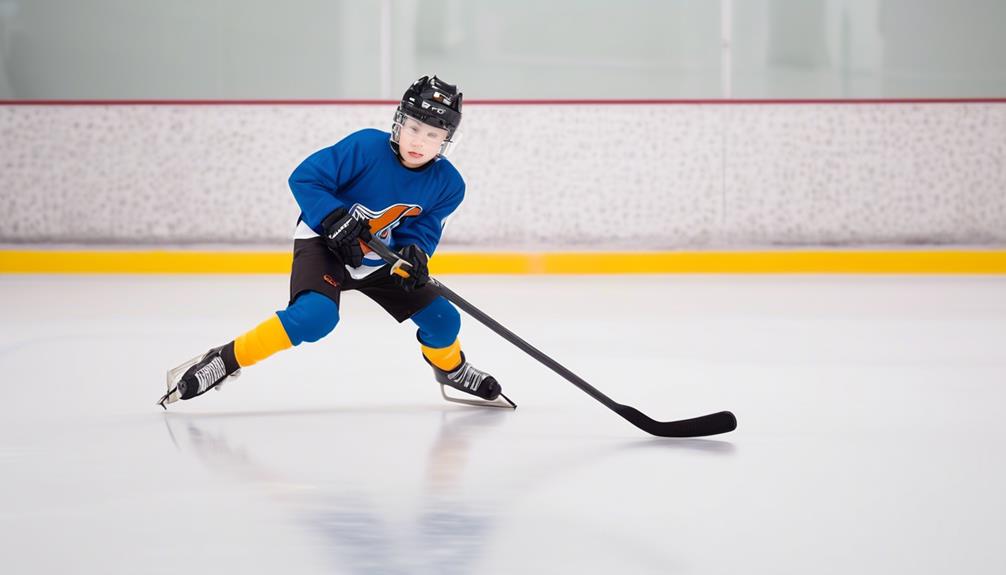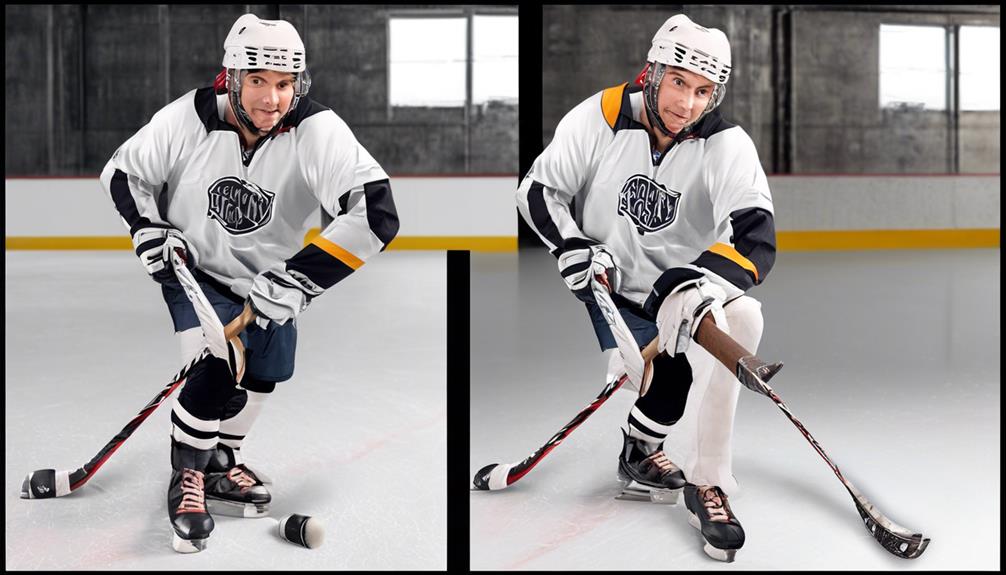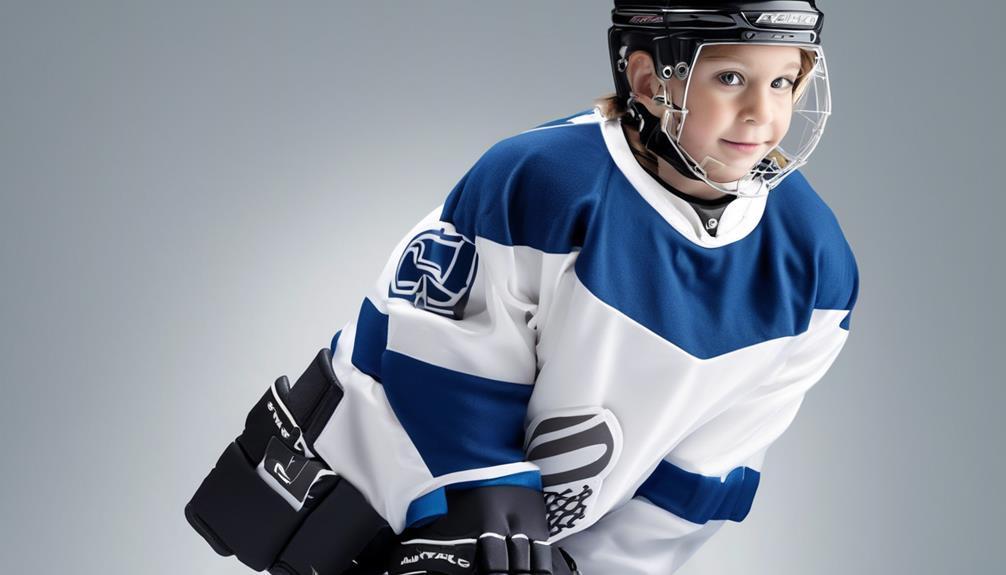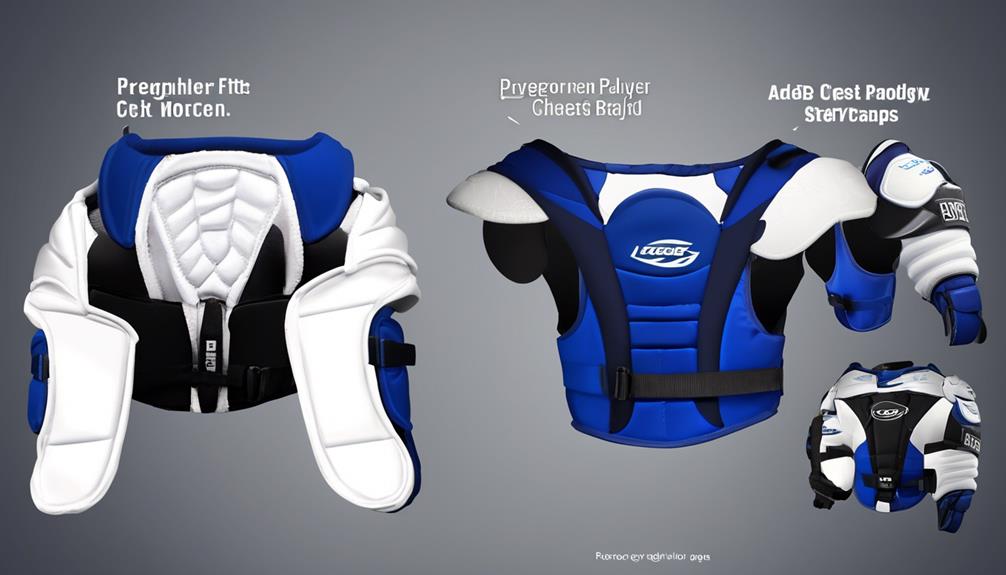Why Is the Best Hockey Equipment for Beginners?
You might be thinking that as a beginner, you could get away with using just any old hockey equipment. However, the truth is that having the right gear can make a significant difference in your overall experience on the ice.
From properly fitted skates to the right stick and essential protective gear, each piece plays a crucial role in your performance and safety.
But what exactly makes the best hockey equipment for beginners?
Importance of Properly Fitted Skates

To skate effectively and avoid injury, it's crucial that you wear properly fitted skates. Ill-fitting skates can lead to blisters, foot pain, and even ankle injuries. Properly fitted skates provide the necessary support and comfort for maneuvering on the ice. To ensure your skates remain in good condition, regular skate maintenance is essential. This includes sharpening the blades, checking for any signs of wear and tear, and ensuring the boots are free from any damage.
When it comes to lacing your skates, using proper lacing techniques is vital for both performance and safety. Start by loosening the laces and then slide your foot into the skate, ensuring your heel is pushed firmly against the back. Begin lacing the skates from the toe, making sure each set of eyelets is pulled tight before moving on to the next. This ensures a snug and secure fit, providing the necessary ankle support while preventing any unnecessary movement within the boot.
Skate maintenance should be a routine part of your hockey equipment care. Regularly inspect your skates for any signs of damage and get them sharpened as needed. Additionally, always untie and loosen your laces after each use to allow the skate to dry properly, preventing the build-up of moisture that can lead to deterioration of the materials.
Essential Protective Gear for Safety
Skating effectively and avoiding injury relies heavily on wearing properly fitted skates, and it's equally important to outfit yourself with essential protective gear for safety on the ice. When it comes to protective gear, mouthguard protection is crucial.
A mouthguard not only protects your teeth and jaws but also reduces the risk of concussion by absorbing and dispersing the impact from hits or falls. Ensure that the mouthguard you choose offers both protection and comfort, as you'll need to wear it for extended periods.
Another essential protective gear is proper padding. The importance of proper padding can't be overstated. It not only provides protection from impacts but also ensures mobility. When selecting elbow and shin pads, make sure they fit snugly without restricting movement. Additionally, invest in quality shoulder pads that cover a significant portion of your upper body without hindering your ability to maneuver.
For overall safety, don't overlook the importance of a well-fitted helmet. Look for a helmet with a sturdy cage or visor to shield your face and eyes from flying pucks and sticks. A helmet that fits properly is essential for head protection, and it should be worn at all times on the ice.
Lastly, a well-fitting pair of gloves is vital for hand and wrist protection. Look for gloves with ample padding and wrist support to shield these vulnerable areas from impact. Remember, the right protective gear not only keeps you safe but also gives you the confidence to fully immerse yourself in the game.
Choosing the Right Stick

When selecting a hockey stick, consider the length and flexibility that best suits your playing style and preferences. The right stick can significantly impact your performance on the ice, so it's crucial to make an informed decision. Here are some key factors to consider when choosing the right stick:
- Choosing the right flex: The flex of a stick refers to its stiffness, and it plays a crucial role in your shooting power and accuracy. A general rule of thumb is to select a flex rating that's around half of your body weight. This allows for the right amount of flex to generate power without sacrificing control.
- Blade: The blade of the stick is where the magic happens. It's essential to consider the curve, lie, and material of the blade. The curve affects your ability to lift the puck, the lie impacts your stick handling, and the material influences the durability and feel of the puck.
- Proper stick length and grip: The length of your stick should complement your height and skating style. A longer stick offers more reach, while a shorter stick provides better control. Additionally, finding the right grip for your stick is crucial for handling and maneuvering the puck effectively.
Choosing the right stick is a personal decision that can greatly impact your game. By paying attention to these key aspects, you can ensure that your stick enhances your skills and overall enjoyment of the sport.
Impact of Quality Helmets
Selecting the right hockey stick can greatly enhance your game, and now it's crucial to understand the impact of quality helmets on your safety and performance on the ice. When it comes to helmet technology, advancements have been made to improve concussion prevention. Quality helmets are designed with materials and construction techniques that are specifically engineered to absorb and dissipate impact forces, reducing the risk of head injuries. It's important to invest in a helmet that meets the latest safety standards to provide the best possible protection.
In addition to helmet technology, ensuring the right fit, comfort, and stability is essential. A properly fitting helmet should sit snugly on your head without causing any pressure points. Many helmets come with adjustable features, such as a dial-fit system, to customize the fit according to your head shape and size. Comfort is key, as it ensures you won't be distracted by discomfort during play, allowing you to fully focus on the game. Furthermore, a stable helmet will stay in place during sudden movements, providing consistent protection.
Ultimately, the impact of quality helmets on your safety and performance can't be overstated. By investing in a helmet with advanced technology and ensuring proper fit, comfort, and stability, you can significantly reduce the risk of head injuries and play with confidence and peace of mind on the ice.
Importance of Properly Fitted Gloves

Invest in gloves that fit snugly around your hands to ensure maximum protection and dexterity while playing hockey. Properly fitted gloves are essential for a beginner to feel comfortable and confident on the ice.
Here's why glove comfort and hand protection are crucial for your hockey experience:
- Reduced Risk of Injury: Well-fitted gloves provide proper protection for your hands, shielding them from slashes, pucks, and falls. This reduces the risk of hand injuries, allowing you to focus on improving your game without the fear of getting hurt.
- Enhanced Grip: Gloves that fit well enable you to have a proper grip on your stick, enhancing your ability to control the puck. With a secure grip, you'll feel more connected to the game, leading to improved puck control and better overall performance on the ice.
- Improved Confidence: When your gloves fit perfectly, you'll notice a significant difference in your confidence levels. The comfort and security they provide can help you stay focused on developing your skills and enjoying the game, knowing that your hands are well-protected.
Investing in properly fitted gloves isn't just about protecting your hands; it's about ensuring that you have the best opportunity to excel in the sport. By prioritizing glove comfort and hand protection, you'll be setting yourself up for success as you embark on your hockey journey.
Understanding the Role of Shin Guards
To continue your journey of hockey equipment understanding, let's now explore the crucial role of shin guards in protecting your lower body during gameplay.
Shin guards are essential for safeguarding your shins, knees, and calves from potential impacts, slashes, and pucks during intense hockey matches. When choosing shin guards, comfort is key. Look for guards with adequate padding and cushioning to ensure a comfortable fit that allows for unrestricted movement on the ice.
Proper sizing is crucial for both comfort and protection. Ill-fitting shin guards can lead to discomfort, chafing, and reduced mobility, impacting your performance on the ice. To find the right size, measure the distance from the center of your kneecap to the top of your skate. This measurement will help you select the appropriate shin guard size to ensure a snug and secure fit.
Keep in mind that different brands may have slightly different sizing, so it's important to refer to each manufacturer's specific sizing guidelines. Additionally, consider trying on the shin guards with your hockey socks and skates to ensure a proper fit.
Selecting the Right Shoulder Pads

When considering the right shoulder pads for your hockey gear, prioritize protection and comfort to enhance your performance on the ice. The shoulder pads you choose should provide adequate protection against impacts, while allowing you to move freely and comfortably.
Here are some key points to consider when selecting the right shoulder pads:
- Padding Technology: Look for shoulder pads that incorporate advanced padding technology, such as multi-density foams or gel inserts. These technologies offer superior impact absorption, dispersing the force of collisions and protecting your shoulders from injury. Knowing that you have top-of-the-line protective gear can give you the confidence to play fearlessly and perform at your best.
- Size Adjustment: Opt for shoulder pads with customizable fit features, like adjustable straps or Velcro closures. The ability to adjust the fit ensures that your shoulder pads stay securely in place during gameplay, preventing them from shifting or sliding around. A snug and secure fit not only enhances your safety but also provides a sense of reassurance, allowing you to focus on your game without distractions.
- Comfort and Mobility: Seek shoulder pads that offer a balance between protection and mobility. Look for designs that provide ample coverage and protection without restricting your range of motion. Finding shoulder pads that allow you to move freely and comfortably can boost your agility and overall performance on the ice.
Selecting the right shoulder pads is crucial for both your safety and performance, so take the time to find a pair that offers the perfect combination of protection, comfort, and mobility.
Benefits of Quality Goalie Equipment
After ensuring you've selected the right shoulder pads for optimal protection and comfort, the benefits of quality goalie equipment become equally essential for your performance on the ice. When it comes to quality goaltender performance, having the right equipment can make a significant difference.
Quality goalie equipment features advanced padding and materials that not only provide superior protection but also offer enhanced mobility and comfort, allowing you to move freely and confidently in the net.
One of the primary benefits of quality goalie equipment is the superior protection it offers. Modern goalie gear is designed with advanced technologies and materials that can absorb and disperse the impact of pucks, sticks, and collisions, reducing the risk of injury. This protection is crucial for maintaining your confidence and focus during intense gameplay, knowing that you're well-protected against any shots or unexpected contact.
Additionally, quality goalie equipment is designed to optimize your performance on the ice. The gear's lightweight and ergonomic design enable you to move more efficiently, react quicker to shots, and maintain your agility throughout the game. This can directly impact your ability to make crucial saves and maintain a strong presence in the goal crease.
Furthermore, investing in high-quality goalie equipment can contribute to your overall durability and longevity as a goaltender. The durability of the gear ensures that it can withstand the rigors of regular use, providing reliable performance season after season. Ultimately, choosing top-notch goalie equipment is an investment in your safety, performance, and long-term success as a goaltender.
Frequently Asked Questions
What Are the Best Off-Ice Training Exercises for Beginner Hockey Players?
To build strength and agility for hockey, start with off-ice training exercises like squats and ladder drills. Focus on proper nutrition to fuel your workouts and prevent injuries. Stay consistent for progress.
How Can Beginners Improve Their Hockey Stick Handling Skills?
To improve your stick control and stickhandling techniques, practice drills that focus on wrist strength. Incorporate quick, precise movements to enhance your skills. Consistent practice will help you develop better control and confidence on the ice.
What Are Some Common Mistakes to Avoid When Purchasing Hockey Equipment for Beginners?
When buying hockey equipment for beginners, avoid overspending and ensure proper sizing to prevent discomfort and injury. Look for affordable, quality gear that fits well and provides the necessary protection for an enjoyable learning experience.
What Is the Best Way to Break in New Hockey Skates for Beginners?
To break in new hockey skates for beginners, start by wearing them around the house to ensure a comfortable fit. Then, hit the ice for a few practice sessions. Proper maintenance will keep them in top shape.
Are There Any Specific Recommendations for Beginner Goalie Equipment?
You should look for a goalie mask that provides good visibility and protection. A chest protector with adjustable straps can ensure a proper fit and maximum coverage. It's important to prioritize safety and comfort when choosing beginner goalie equipment.
Conclusion
So, when it comes to choosing the best hockey equipment for beginners, it's important to prioritize safety, comfort, and performance.
Properly fitted skates, essential protective gear, the right stick, quality helmets, gloves, shin guards, shoulder pads, and goalie equipment all play a crucial role in ensuring a positive and successful experience on the ice.
Investing in high-quality equipment from the start will set you up for success as you continue to develop your skills in the sport of hockey.
